
Join Clean Fleet Report
Login to Clean Fleet Report
Reset Password
Enter the username or e-mail you used in your profile. A password reset link will be sent to you by email.
Loading…

Enter the username or e-mail you used in your profile. A password reset link will be sent to you by email.
Loading…
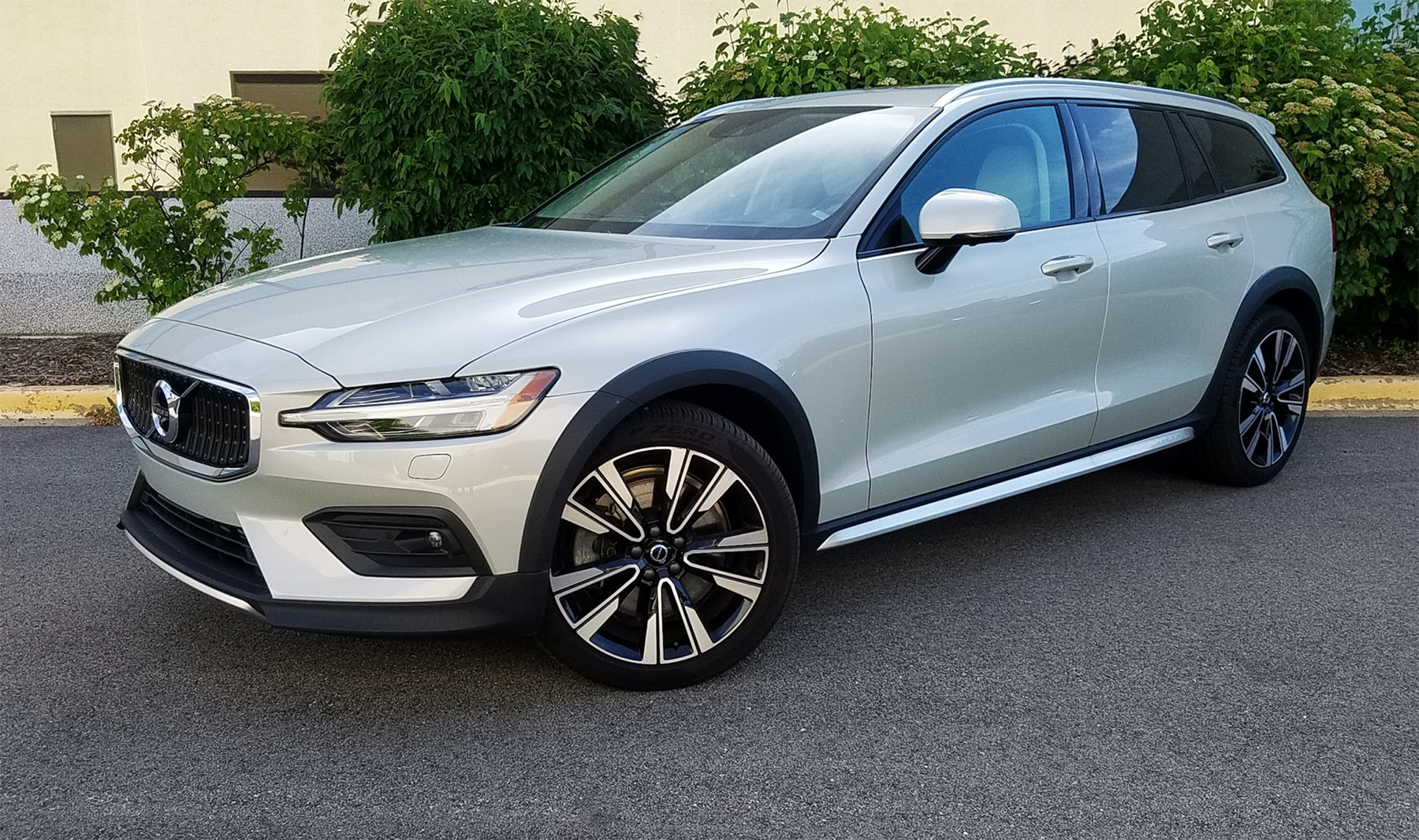
2020 Volvo V60 T5 Cross Country in Birch Light Metallic (a $645 option)
 2020 Volvo V60 T5 Cross Country
2020 Volvo V60 T5 Cross CountryClass: Premium Midsize Car
Miles driven: 395
Fuel used: 16.4 gallons
| CG Report Card | |
|---|---|
| Room and Comfort | B- |
| Power and Performance | B- |
| Fit and Finish | A |
| Fuel Economy | B |
| Value | B |
| Report-card grades are derived from a consensus of test-driver evaluations. All grades are versus other vehicles in the same class. Value grade is for specific trim level evaluated, and may not reflect Consumer Guide’s impressions of the entire model lineup. | |
| Big & Tall Comfort | |
| Big Guy | C |
| Tall Guy | C+ |
| Big & Tall comfort ratings are for front seats only. “Big” rating based on male tester weighing approximately 350 pounds, “Tall” rating based on 6’6″-tall male tester. | |
| Drivetrain | |
| Engine Specs | 250-hp 2.0L |
| Engine Type | Turbo 4-cylinder |
| Transmission | 8-speed automatic |
| Drive Wheels | AWD |
Real-world fuel economy: 24.1 mpg
Driving mix: 55% city, 45% highway
EPA-estimated fuel economy: 22/31/25 (city, highway, combined)
Fuel type: Premium gas required
Base price: $45,100 (not including $995 destination charge)
Options on test vehicle: Advanced Package ($2500), Cross Country Pro Package ($2800), heated rear seats and steering wheel ($750), metallic paint ($645), Bowers and Wilkins premium sound system ($4000), Park Assist Pilot ($200)
Price as tested: $56,990
The great: Beautifully finished cabin, ride/handling balance
The good: Distinctive styling; compelling mix of car-based-wagon and SUV virtues
The not so good: Complicated touchscreen interface; powertrain sounds a bit coarse at low speeds; occupant space is a bit stingy, especially when compared to crossover SUVs
More V60 price and availability information
Volvo sells two lines of passenger cars and three crossovers in the U.S. The cars, the S60/V60 and S90/V90 sedans (“S”) and wagons (“V”), curiously are both big enough to fit in the premium midsize category, though the 60 line is the physically smaller of the two. The V90 has had an SUV-ish all-wheel-drive version—called Cross Country—since 2017. A Cross Country version of the previous-generation V60 was offered from 2015-2018, but took a model year off when the V60 was redesigned for 2019. For 2020, however, the V60 Cross Country is back.
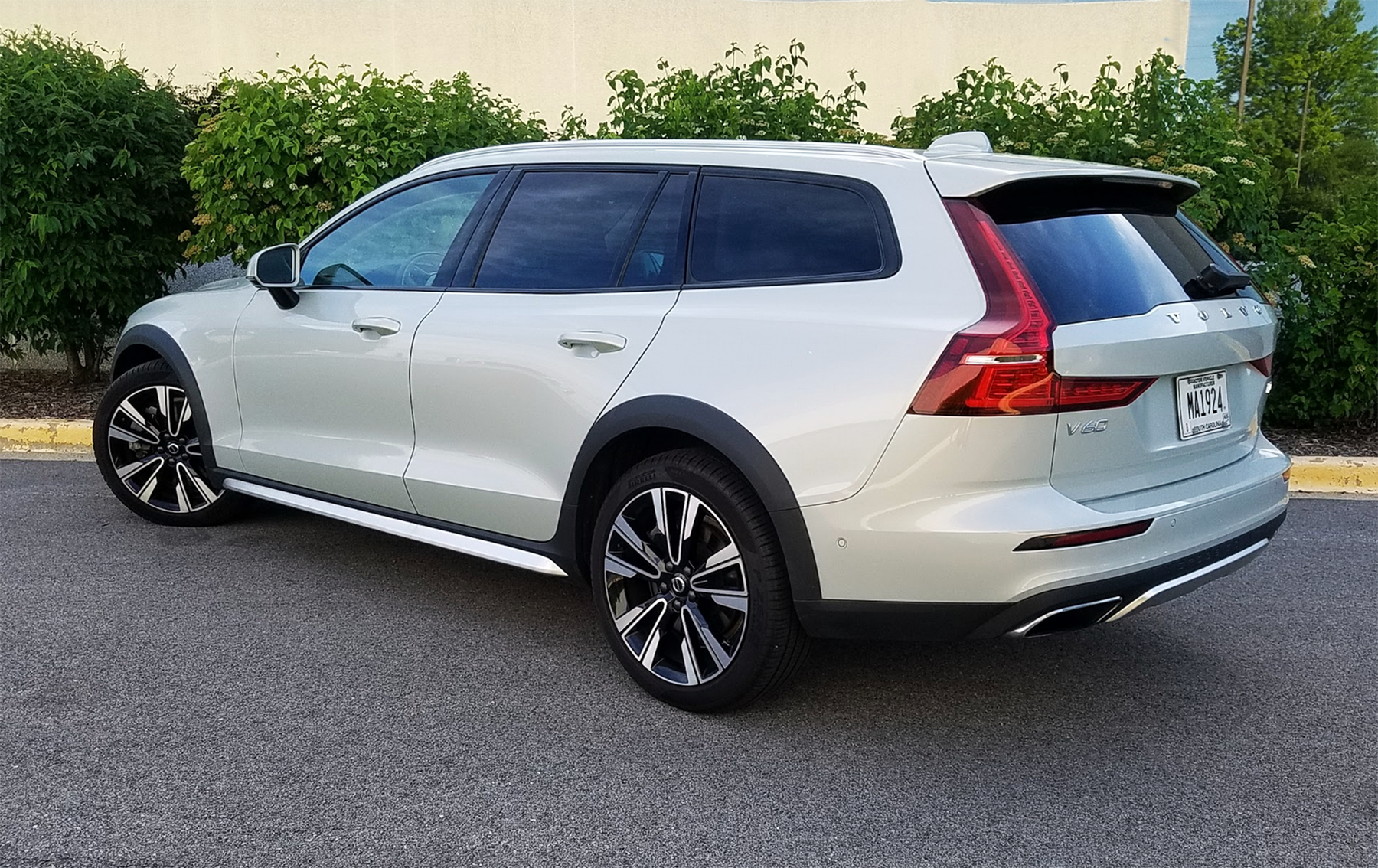
The Cross Country model adds SUV-style body cladding and a raised ride height to Volvo’s stylish V60 wagon.
Standing still, the Cross Country stands out from front-wheel-drive V60s by dint of its 2.5-inch-loftier ride height (7.9 inches total) and black body cladding around the wheel openings and along the rocker panels. Its starting price of $46,740 (with delivery) makes it the cheapest AWD V60 by a country mile—the Polestar performance model that’s also new for 2020 costs almost $22,000 more. Pricewise, the Cross Country actually falls in between the two least-expensive front-drive V60s.
For 2020, the V60 drops the 316-horsepower T6 engine that’s turbocharged and supercharged, leaving just the 250-horsepower T5 turbocharged 2.0-liter 4-cylinder engine for most models. (The exception is the Polestar with T8 power—a turbocharged, supercharged, plug-in-hybrid version of the 2.0 that makes 415 horsepower.) The transmission is an 8-speed automatic.
Quick Spin: 2020 Subaru Outback Touring XT
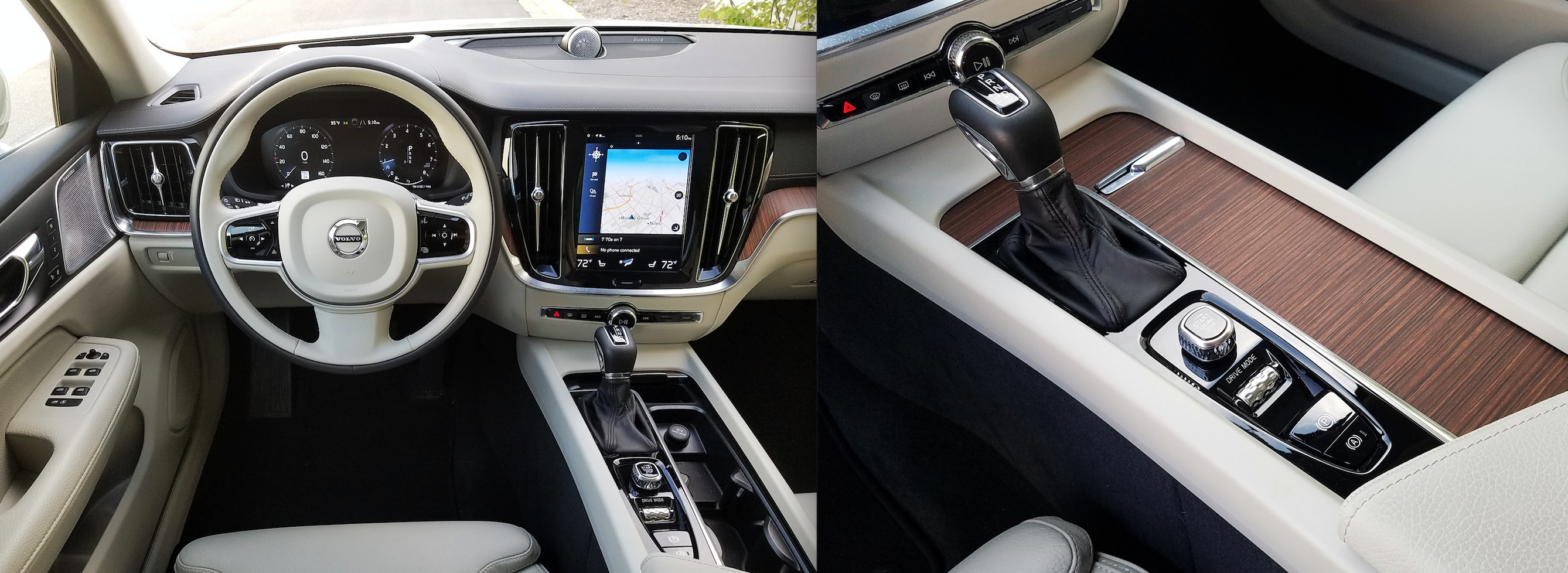
The V60’s cabin trimmings are genuinely luxurious, especially when outfitted with the $2800 Cross Country Pro Package. The center console houses Volvo’s signature twist-knob engine start/stop control, drive-mode selector dial, electronic parking brake; cupholders and 12V charge port are under a handsome sliding cover.
Contrary to the V60’s polish in many other areas, the T5 powerplant is a little grumbly at low speeds. Once it clears its throat, though, the car behaves responsively. It is a calm highway cruiser, and the transmission kicks down alertly when passing power is required. “Dynamic” driving mode enlivens power delivery somewhat. Going the standard-AWD route pushes the Cross Country’s weight above 4000 pounds, so fuel economy (22 mpg city/31 mpg highway/25 mpg combined per the EPA) isn’t quite as good as with the front-drivers. This reviewer charted 22.31 mpg from a run of 64.6 miles that included 46 percent city-type driving.
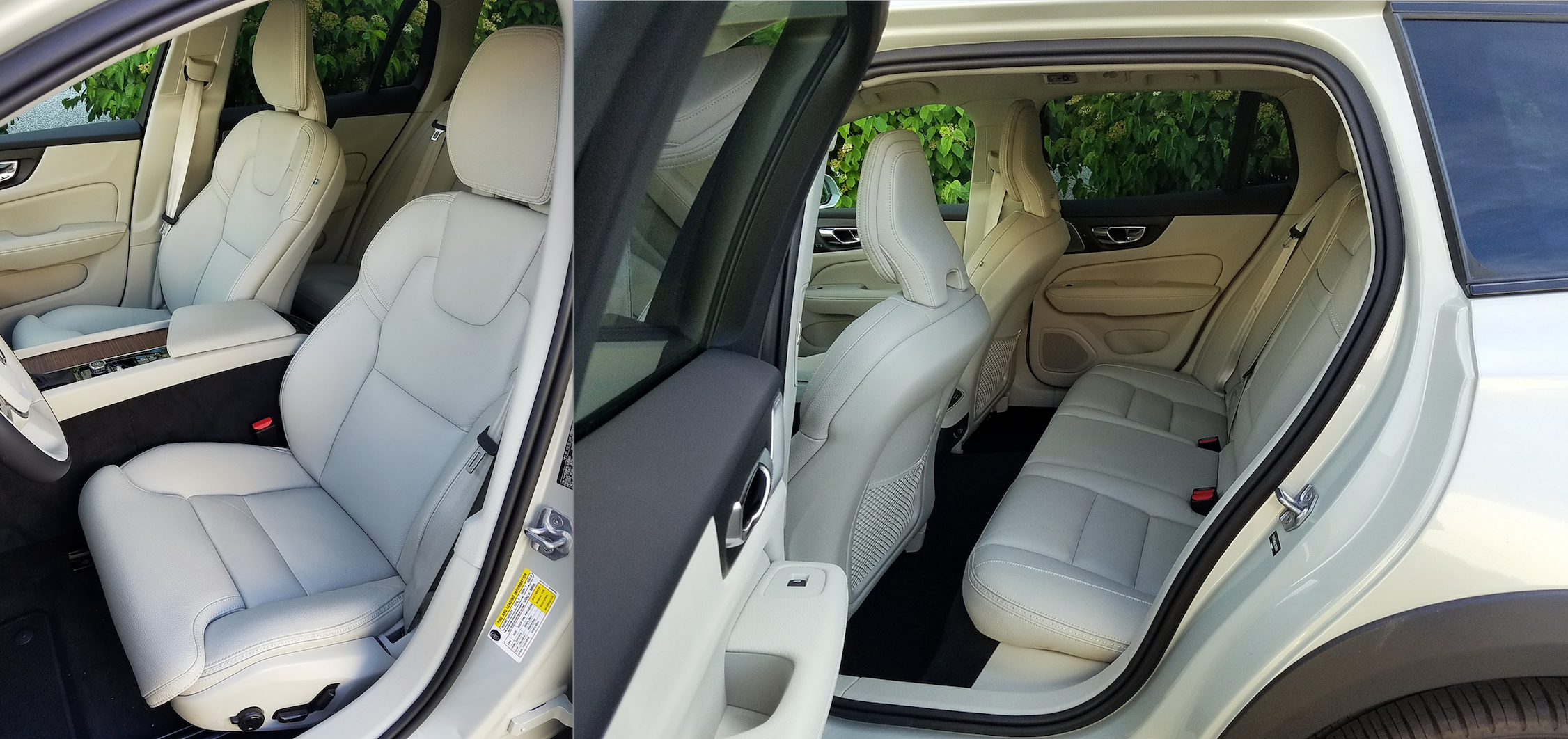
The V60’s front seats are especially supportive and comfortable, but the cabin is cozy enough that big and tall occupants might wish for more space… even in the front seats.
The AWD driveline doesn’t prevent the Cross Country from delivering a pleasing balance of good ride and handling. “Station wagon” and “cumbersome” are not synonymous here. The Dynamic setting tweaks steering and braking responses. Standard hill-descent control gives the Cross Country an additional element for the “almost-an-SUV” image it hopes to foster.
The Cross Country is as much a trim level as it is a mechanical package. Unlike the front-drive V60s available with Momentum, R-Design, or Inscription equipment, the Cross Country comes one way—though it can be dressed up with options. Standard equipment includes things like leather upholstery, heated front seats, dual integrated tailpipes, body-color exterior-mirror caps, panoramic sunroof, forward-collision warning and mitigation with pedestrian/cyclist/large-animal detection, lane-departure warning and mitigation, oncoming-traffic mitigation, and road-sign identification.
2019 Los Angeles Auto Show: Volkswagen ID Space Vizzion Concept
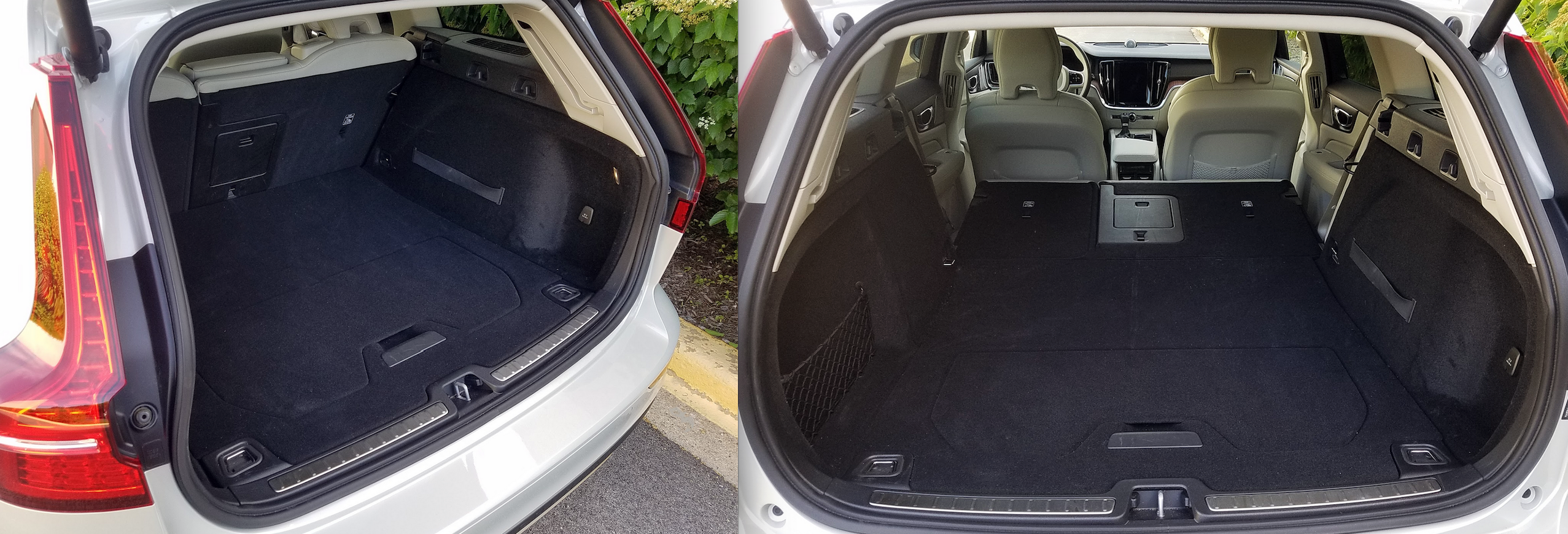
There’s 23.2 cubic feet of cargo volume behind the V60’s rear seats, which expands to 50.9 cubic feet of space with the rear seat backs folded–numbers that are comparable to the small end of the compact crossover SUV class.
The quiet cabin is coolly chic, with plush and attractive surfaces just about everywhere. We just have to wonder if the striking off-white Blond interior that was in the test car is the best choice for this pseudo-SUV V60. “Iron Ore” metallic accents are standard, but the tester sported Linear Limewood inlays on the instrument panel and console. (The wood is only available in a $2800 Pro Package option that also includes passenger-seat memory; heated power cushion extensions and 4-way power lumbar support for the front seats; a tailored Charcoal dashboard covering with contrast stitching; interior high-level illumination; 4-zone automatic climate control; cargo-area grocery-bag holder; 19-inch 5-double-spoke diamond-cut alloy wheels; and an exterior-styling kit that adds brushed stainless steel to the rockers, front and rear bumper “skid plates,” and tailpipe finishers.)
Front passengers will find the V60 comfortable and reasonably roomy. Rear legroom will accommodate folks up to about 6 feet tall, but the driveline hump is just wide enough to rule out effective 3-across seating, even perhaps for teenagers. Also, the inward “tumblehome” of the roof brings it close to outboard passengers’ heads. Curiously, per the manufacturer, there is 0.7 inch more second-row headroom even though that sense doesn’t come through when actually seated. Driver sightlines around the cabin are pretty decent overall.
Quick Spin: 2019 Volvo V90 R-Design
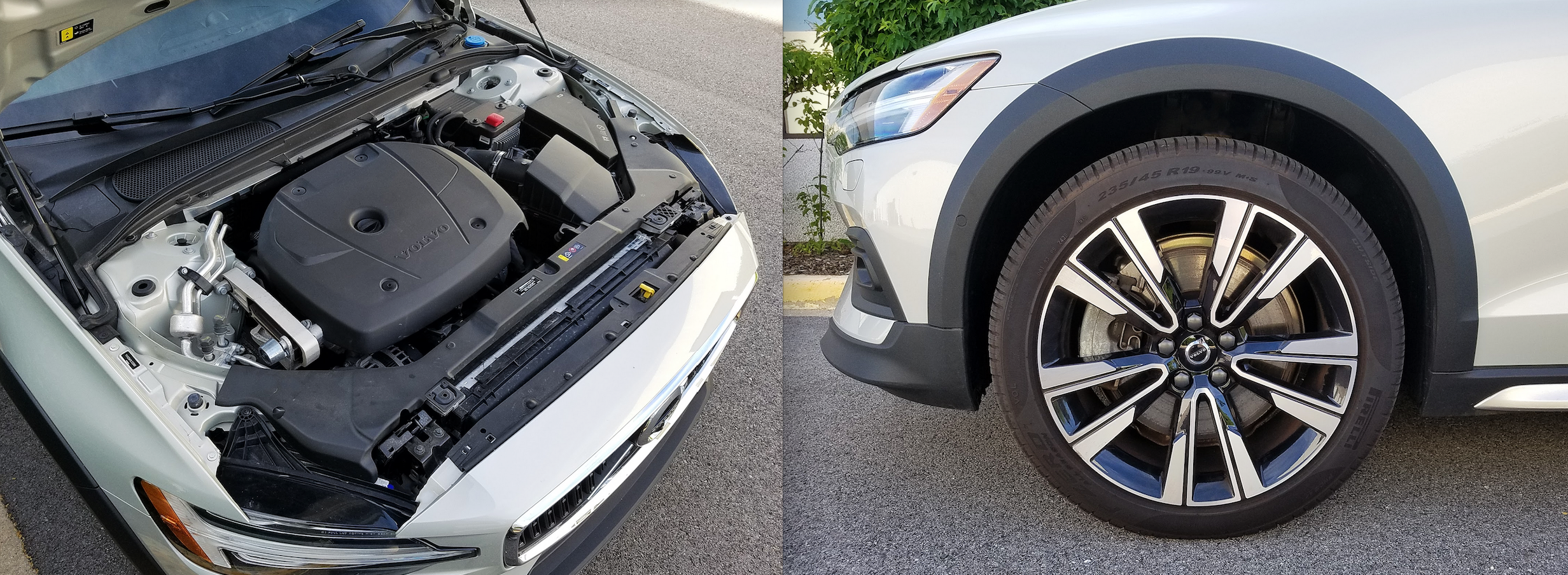
The V60 Cross Country’s lone engine choice is a turbocharged 2.0-liter 4-cylinder that makes 250 horsepower. Included in the Cross Country Pro Package are 19-inch alloy wheels that replace the standard 18s.
Driving instruments display well, but infotainment is controlled by Volvo’s signature big, vertical, tablet-like screen that has been a consistent target of CG complaints for its complexity. In the Cross Country, it didn’t always respond well to this driver’s swipes, which started to get him more concerned with making the system work than with the road. On the climate system, handy dials set temperatures, while buttons control other functions. Climate settings can be done on the screen, too, if you prefer. Rear passengers are presented with their own climate controls built into the back of the console.
Personal-item storage options in front come down to a big glove box, small padded-top console box, covered cup holders in the console, and door pockets. Second-row facilities are net pouches on the backs of the front seats; a pull-down armrest with pop-out cup holders, an exposed tray (about big enough to rest a phone), and a shallow covered bin; and door pockets.
The cargo area has useful flat-floored space that loads at bumper height, but no underfloor capacity. Rear seats fold flat in a 60/40 split for up to 60.5 cubic feet of load space, and there is a long-object pass-through available when the rear armrest is down. A net pouch on the left side of the cargo bay and elastic strap on the right side can hold incidentals in place. The top of the power liftgate extends into the roof to help it open high out of the way for easier loading.
If your needs don’t require maximum passenger space, but your desires are for comfort and sophistication at a not-bank-busting price, the Volvo V60 Cross Country could be for you.
Review Flashback! 2005 Saab 9-2X
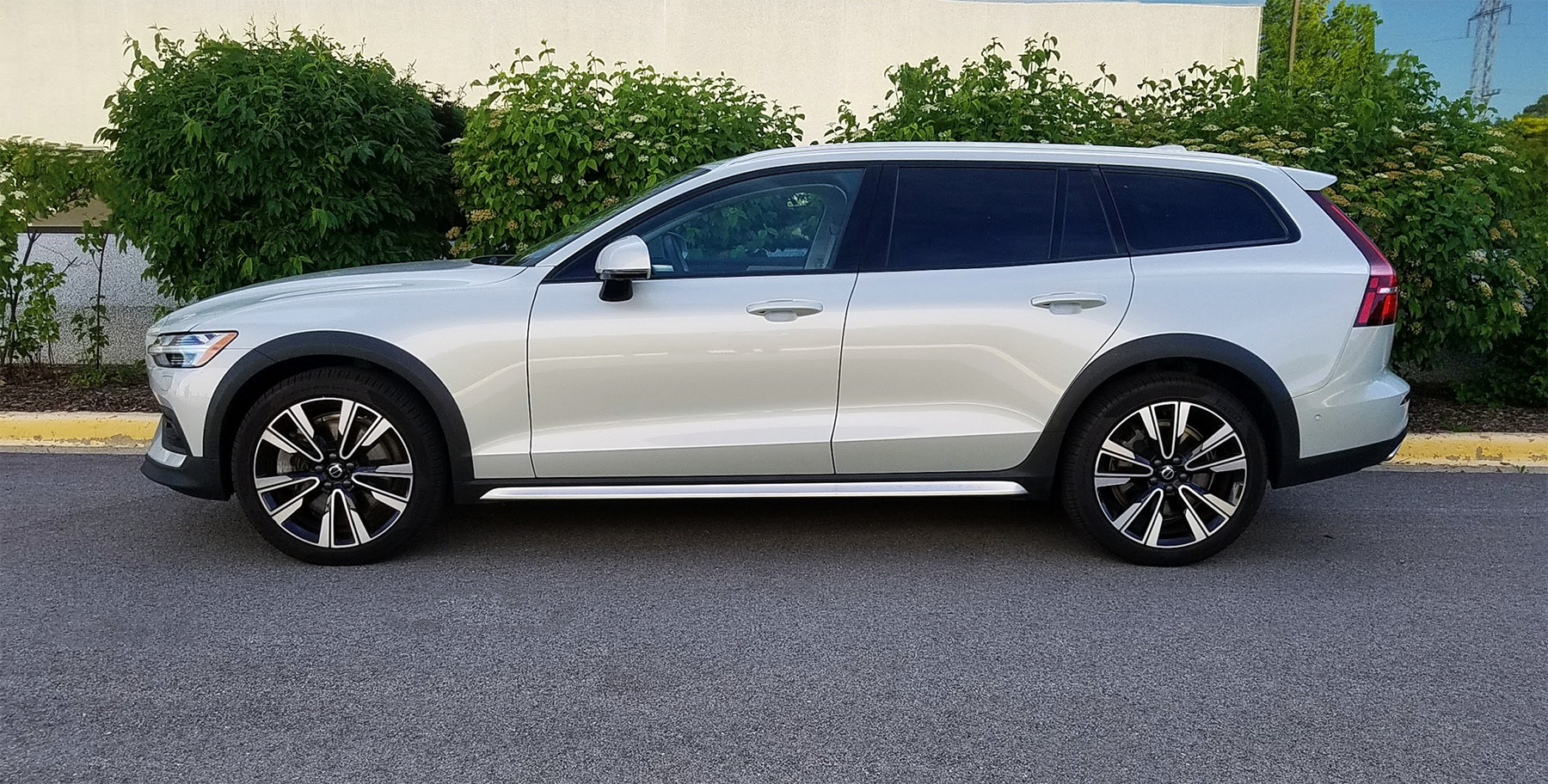
As crossover SUVs have largely taken over as America’s family haulers of choice, traditional station wagons are rarities in today’s market (case in point: the non-Cross Country V60 wagon is basically available only by special order). If you prefer the driving dynamics of a passenger car but desire some SUV flavor–and a bit more all-weather and rough-terrain functionality as well–the Volvo V60 Cross Country is a fine option.
Check out the Consumer Guide Car Stuff Podcast
2020 Volvo V60 Cross Country
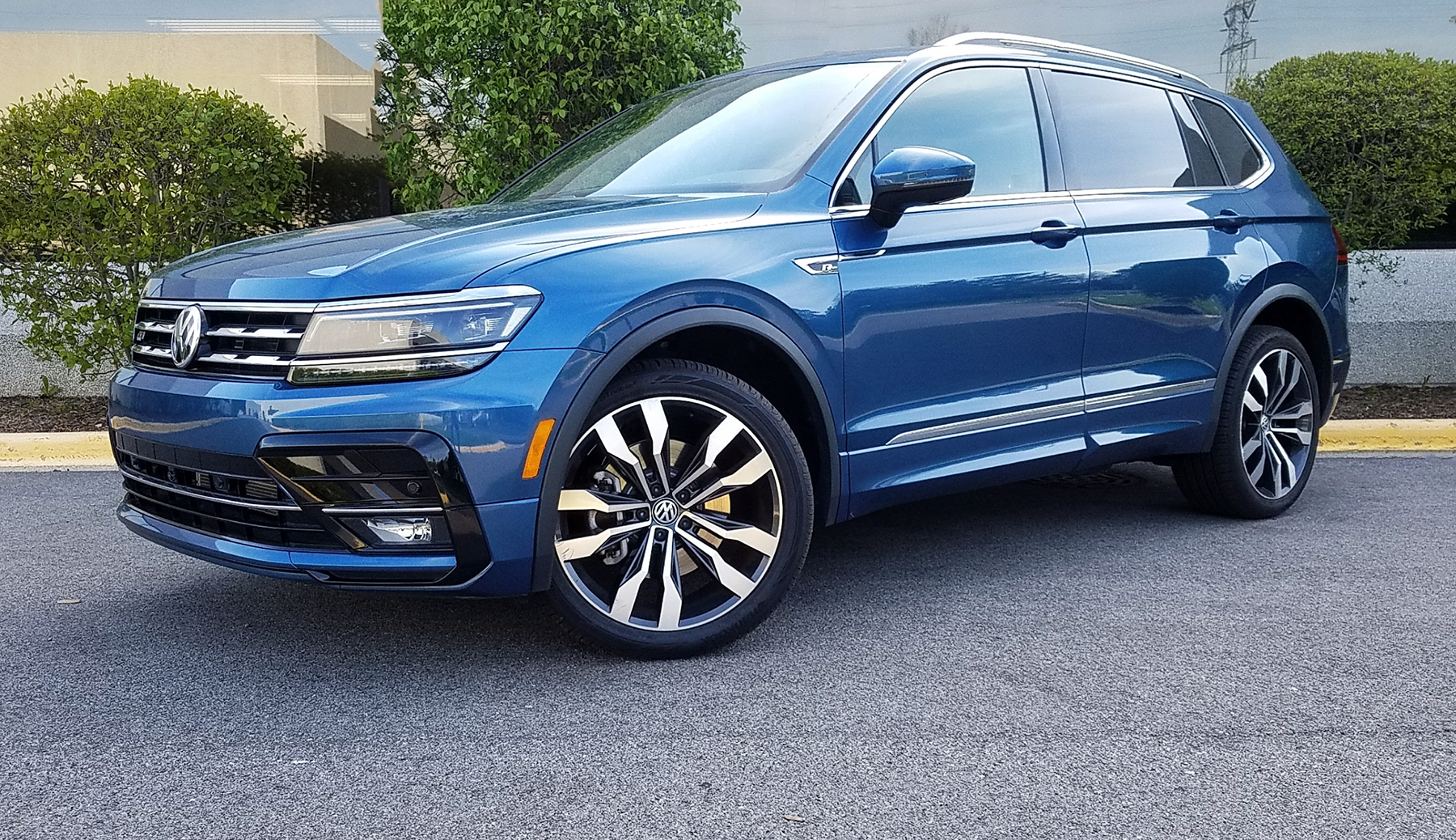
2020 Volkswagen Tiguan SEL Premium R-Line in Silk Blue Metallic
 2020 Volkswagen Tiguan SEL Premium R-Line w/ 4Motion
2020 Volkswagen Tiguan SEL Premium R-Line w/ 4MotionClass: Compact Crossover SUV
Miles driven: 324
Fuel used: 13.8 gallons
| CG Report Card | |
|---|---|
| Room and Comfort | B+ |
| Power and Performance | C+ |
| Fit and Finish | B+ |
| Fuel Economy | B |
| Value | B- |
| Report-card grades are derived from a consensus of test-driver evaluations. All grades are versus other vehicles in the same class. Value grade is for specific trim level evaluated, and may not reflect Consumer Guide’s impressions of the entire model lineup. | |
| Big & Tall Comfort | |
| Big Guy | B+ |
| Tall Guy | A- |
| Big & Tall comfort ratings are for front seats only. “Big” rating based on male tester weighing approximately 350 pounds, “Tall” rating based on 6’6″-tall male tester. | |
| Drivetrain | |
| Engine Specs | 184-hp 2.0-liter |
| Engine Type | 4-cyl |
| Transmission | 8-speed automatic |
| Drive Wheels | AWD |
Real-world fuel economy: 23.4 mpg
Driving mix: 40% city, 60% highway
EPA-estimated fuel economy: 20/27/23 (city, highway, combined)
Base price: $38,795 (not including $1020 destination charge)
Options on test vehicle: Third-row seat package ($595)
Price as tested: $40,410
The great: Excellent second-row-seat legroom and cargo space, nicely balanced road manners
The good: Classy cabin/interior materials, clean control-panel layout
The not so good: Lackadaisical low-speed acceleration, especially from a stop
More Tiguan price and availability information
From the look of things, it seems that nearly every automaker regards its products as works in progress. Once anything new hits the market, are they ever really done with it until its replacement comes out?
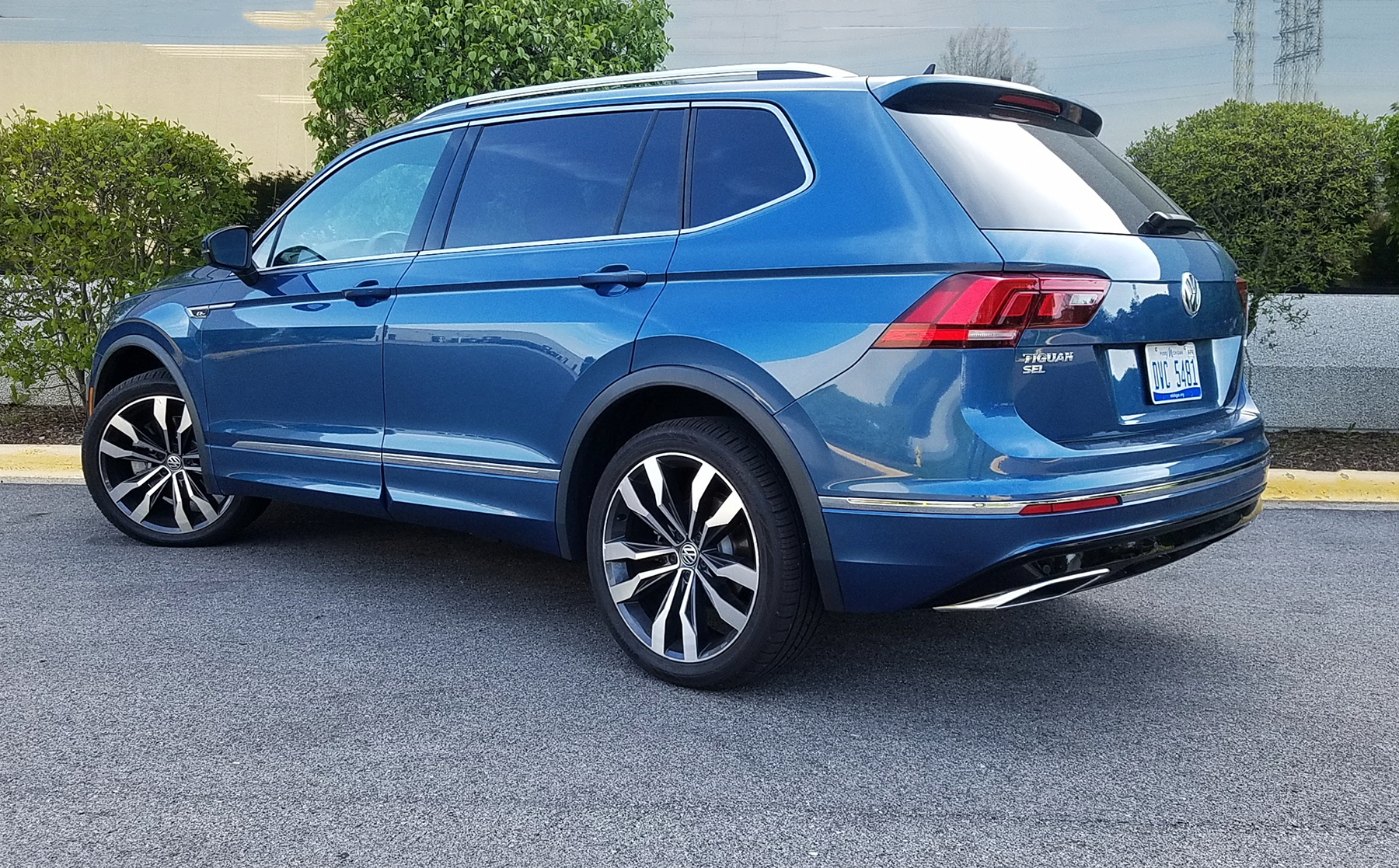
The SEL Premium R-Line comes solely with all-wheel drive and is the top-dog model in the Tiguan lineup; it starts at almost $14,000 more than the front-wheel-drive S model.
Take the Volkswagen Tiguan. VW released the second generation of its compact SUV for 2018 on a larger platform with more cargo room than before and enough space to consider adding a third-row seat. It pretty much stayed the same through 2019, but now, for year three, the 2020 job has a revised model lineup and new or improved technology features.
Consumer Guide tested the Tiguan 2.0T SEL Premium R-Line that continues to sit atop the product line, but the ranks below have been shuffled somewhat. S, SE, and SEL models, all with a choice of front-wheel drive or 4MOTION all-wheel drive, are still cataloged, but the former SEL R-Line has been dropped, which makes room for an SE R-Line Black, again with a choice of drivelines. Also gone is the AWD-only SEL Premium. With standard 4MOTION, the SEL Premium R-Line starts at $39,815 (with delivery); the extra-cost third-row seat nudged the test truck’s tab to $40,410.
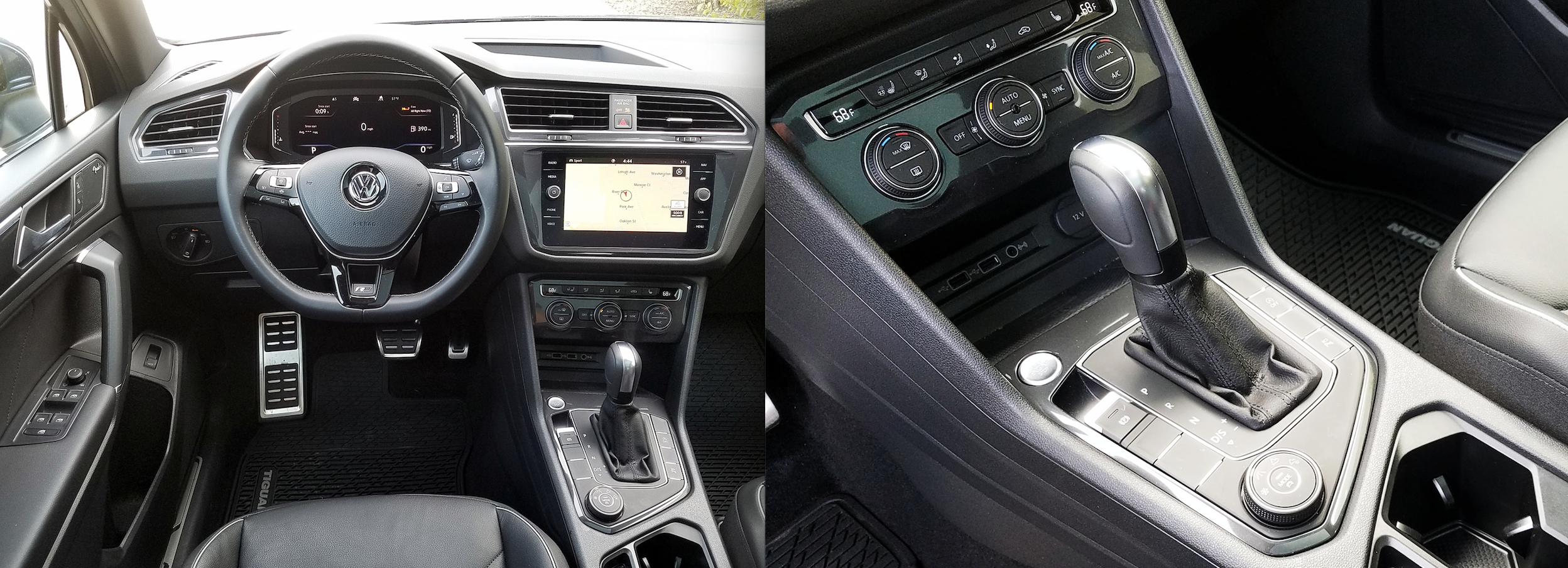
Upscale features of the SEL Premium model include Volkswagen’s Digital Cockpit virtual gauge cluster, leather upholstery, and a nine-speaker Fender audio system. Climate controls are handy rotary dials, and charging ports are located in the leading edge of the center console.
No matter which one a Tiguan customer might buy, it will now have emergency automatic braking with pedestrian detection, blind-spot alert, and rear cross-traffic alert. (The SEL Premium R-Line goes one better by including Active Blind Spot Monitor that adds some countersteer to help resist changing lanes if a vehicle is in the blind spot.) There’s also an updated Car-Net telematics system and Wi-Fi capability for all, plus wireless charging for all but S-level models.
Residing where it does in the Tiguan hierarchy, the SEL Premium R-Line comes pretty well loaded. All R-Lines are identified by a rear sport valance, specific front bumper with a wide lower opening, R-Line badging, 20-inch multi-spoke alloy wheels (with a two-tone machined appearance on the Premium), leather-wrapped steering wheel with R-Line badge, and stainless-steel pedal surfaces. The Premium also boasts leather seats.
Test Drive: 2020 Lexus UX 250h Luxury
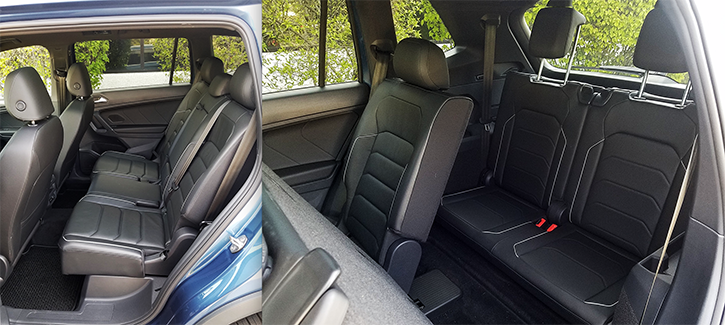
The Tiguan’s second row is spacious enough for adults to ride in comfort, but not surprisingly, the diminutive optional third row is tricky to access and best suited for children. Still, it’s nice to have for the occasional short trip.
In addition to the tech features already described, it also has an overhead-view camera, “Digital Cockpit” instrument display, parking-distance monitors, adaptive cruise control with stop-and-go functionality, headlight high-beam control, remote engine start, keyless entry and starting, hands-free liftgate, Discover Media infotainment system with navigation and 8-inch touchscreen, satellite radio, and a Fender audio system with subwoofer. Other functional and comfort touches encompass full LED exterior lighting (with dynamic cornering lights), power-folding and heated side mirrors with memory function, rain-sensing windshield wipers with heated washer nozzles, a new heated wiper “park” at the base of the windshield, panoramic sunroof, dual-zone climate control, heated steering wheel and front seats, 10-way-adjustable power driver’s seat, cargo cover, and ambient interior lighting.
Accommodations and driving character of the 2020 Tiguan are familiar from CG’s prior runs in examples from this generation. Interior roominess is particularly apparent in the second row, where there’s welcoming legroom for two adults. Seat backs adjust for angle, further enhancing comfort. However, the sunroof skims off some headroom. The third-row seat, a rarity in this size class (the Mitsubishi Outlander is the only other such vehicle with one), may be a handy addition for those who need room for an extra child or two, but it’s too cramped for adult occupancy. Drivers enjoy good sightlines in practically any direction, and entry and exit through all four doors are easy.
Test Drive: 2020 Hyundai Santa Fe Limited (FWD)
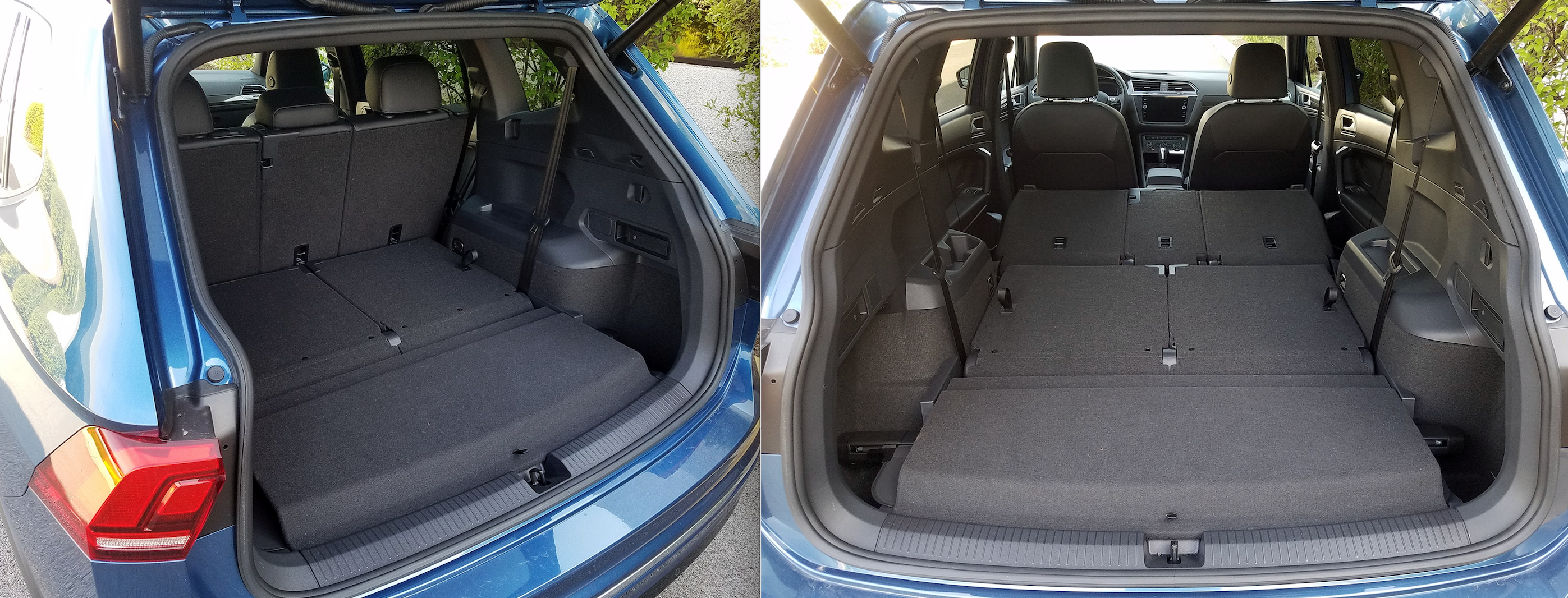
The optional third-row seats eat up a bit of available cargo space, since they raise the cargo floor a bit higher. There’s 12.0 cubic feet behind the third row, 33 cu. ft. behind the second row, and 65.7 cu. ft. with both the second and third row folded. Two-row Tiguans have 37.6 cu. ft. and 73.5 cu. ft., respectively.
Compressible soft-touch material is found atop the dash and on much of the front door panels, but armrests present the only soft areas on the rear doors. The Digital Cockpit enables multiple configurations, and there’s plenty more to be find through the touchscreen. However, some things you’d like to access—say a trip odometer—are dug into the system and a certain amount of fuss to find. Inputting radio presets is more or less intuitive, but takes several button pushes to do what seems should be done in one. Separate dials for temperature settings and fan speed are employed by the climate system, with buttons for other functions.
Test Drive: 2020 Jeep Compass Trailhawk
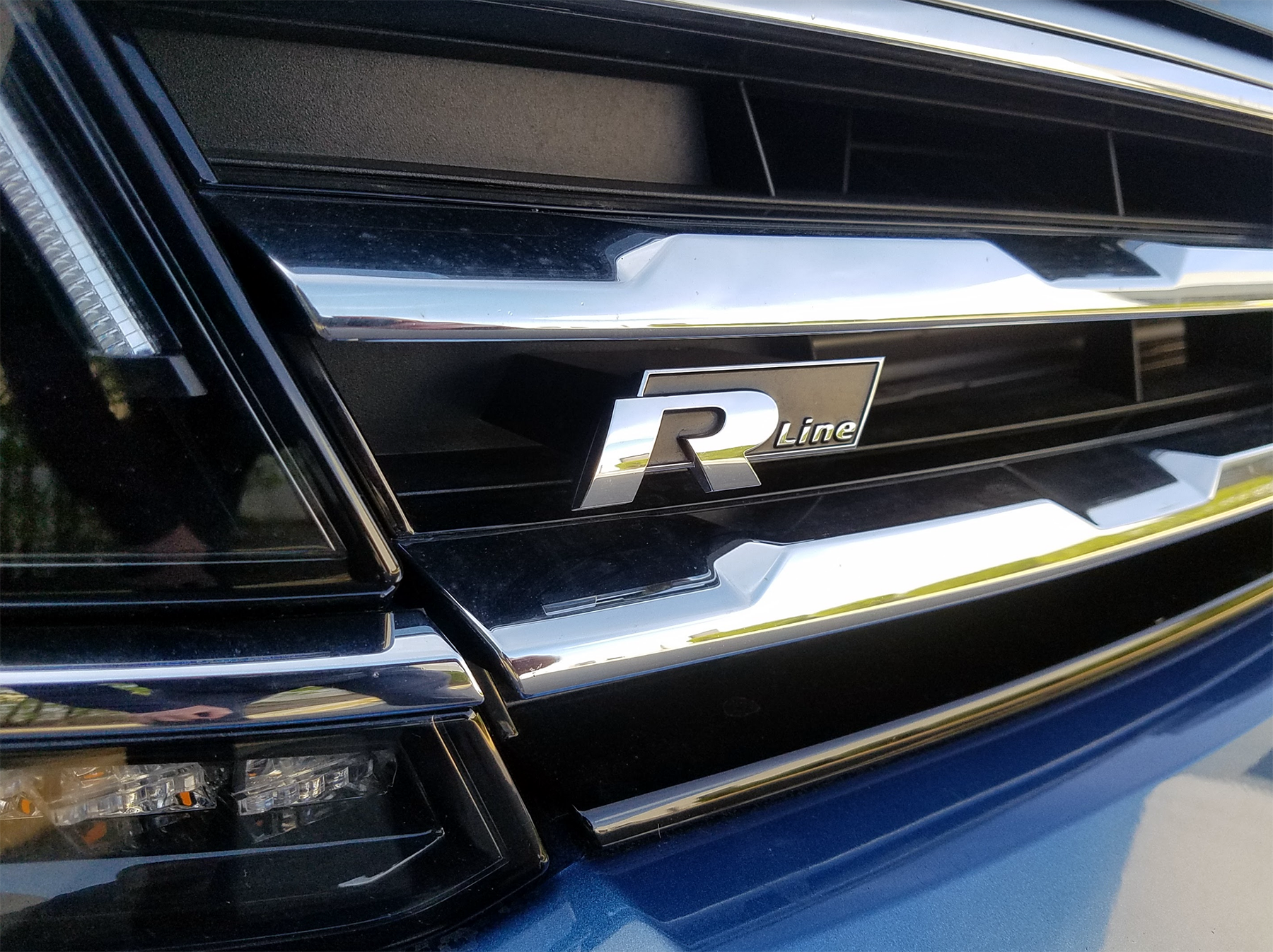
In addition to their upsized wheels and sportier front and rear fasciae, R-Line Tiguans get badges on their front fenders and grille.
Front-row personal-item storage includes a big glove box, small console box, little bin that pulls out of the dash to the left of the steering column, dual exposed cup holders in the console, and door pockets with bottle holders. Device inputs are clustered at the front of the console. The second-row passengers are served by pouches on back of the front seats, door pockets like those in front, cup holders in the pull-down center armrest, and a USB port and 12-volt outlet on the back of the console.
Cargo loads onto a flat floor at bumper height. With the third-row seats up, there’s limited cargo capacity. They fold flat, as do the 40/20/40 second-row seats—albeit with a gap of an inch or more between them and the main cargo floor—to expose 73.5 cubic feet of cargo room. Deep open bins at the rear corners serve to contain incidentals owners might like to keep on hand.
The powerteam remains a 2.0-liter turbocharged 4-cylinder engine and 8-speed automatic transmission. The engine makes 184 horsepower at 5400 rpm and 221 lb-ft of torque at 4300 rpm. It’s adequate, just not inspiring, in around-town driving, though it cruises easily and quietly enough on expressways.
The 4MOTION system has “On-road,” “Snow,” “Off-road,” and “Custom off-road” modes to match powertrain operation to the terrain. On-road opens drivers to “Eco,” “Normal,” “Sport,” and “Custom” options that modify throttle response and transmission operation. Off-road mode utilizes hill-descent control on steep grades for better vehicle control.
Test Drive: 2020 Chevrolet Equinox Premier
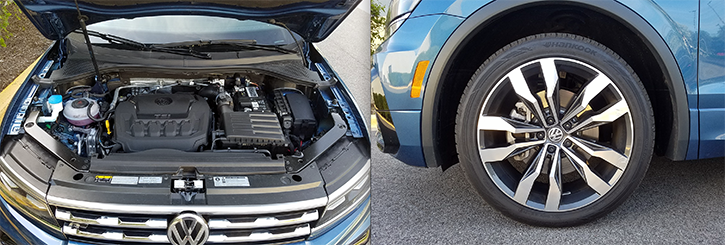
Tiguan R-Lines look sportier than their stablemates, but they don’t get anything special under the hood–they’re equipped with the same 184-hp turbocharged 2.0-liter four as other Tiguans. The R-Line’s standard 20-inch wheels and low-profile tires look great, but take a bit of a toll on ride quality over bumps and rough pavement.
EPA fuel-economy estimates for AWD models like the SEL Premium R-Line are 20 mpg in the city, 27 mpg on the highway, and 23 combined. This tester logged 25.4 mpg from a trip of 62 miles with 25 percent city-type operation. That’s 0.8 mpg better than he got in 2018 in a longer stint with a bit more city driving.
Ride is absorbent without going soft, though the 20-inch wheels make things a bit harsher over sharp bumps. The Tiguan handles well, with firmer steering and an improved sense of control in Sport mode.
If the Volkswagen Tiguan is a work in progress, it’s because there’s progress in its works.
Test Drive: 2020 Honda CR-V Touring
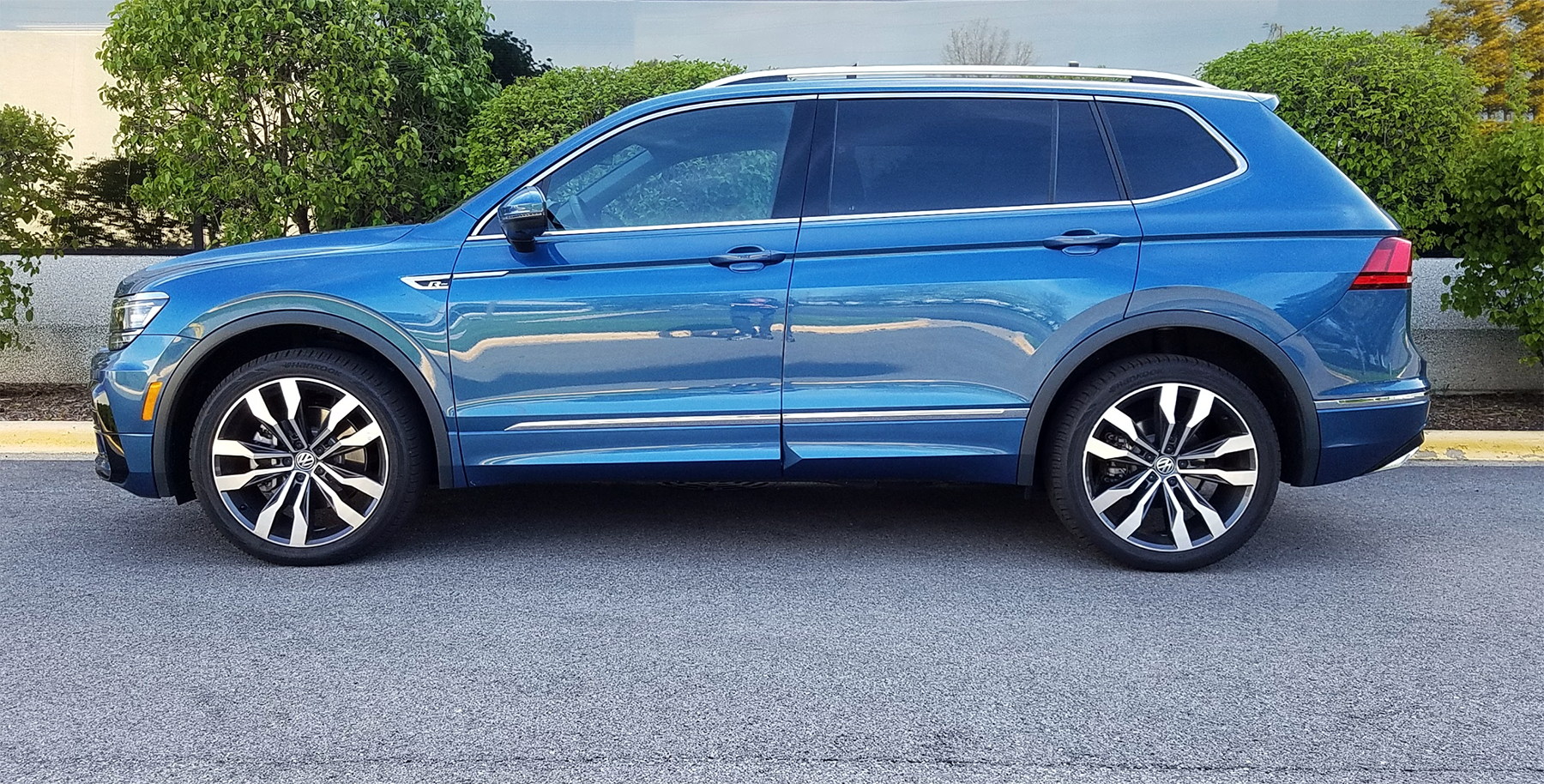
The VW Tiguan continues to be a likeable compact SUV that offers great passenger space and the flexibility of its available third-row seat, but all the bells and whistles of the top-line SEL Premium R-Line model push the bottom-line price past the $40K mark–where there are compelling midsize SUVs to consider.
Quick list of every episode of the Car Stuff Podcast
2020 Volkswagen Tiguan R-Line